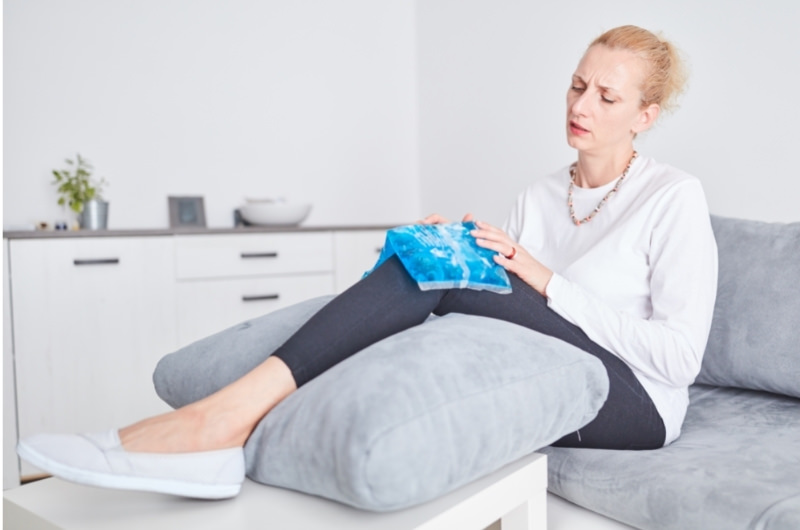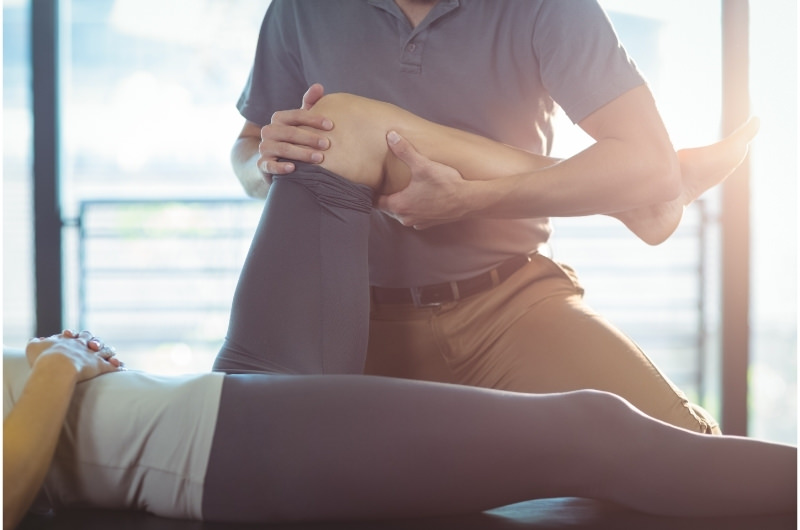Knee manipulations have the obvious intended benefits of improving knee mobility, increasing the range of movements, and strengthening your knee after it has undergone a trauma. However, it can also pose risks if your bones are degraded or if you have any underlying conditions like diabetes or high blood pressure. You can avoid knee manipulations by going through physiotherapy after knee surgery or taking part in prehab programs.
You can also follow simple knee exercises like knee-straightening exercises, and after you notice a development, you can switch to more advanced techniques. The best way to reassure good results is by daily exercise and following icing and elevating routines.
Knee manipulation is one of the more complicated procedures used to heal stiff sensations in your knee and increase the range of motion in your knees.
These knee problems usually occur after traumatic injuries or even after a surgery where scar tissue appears and obstructs the functioning of your joint.
Through knee manipulation, you’ll find more comfort when it comes to moving your legs and recovering the strength of your knee.
So what exactly can you expect from a knee manipulation? What are the benefits and risks involved with this procedure? Can you avoid manipulation after knee surgery and resort to alternatives?
What is the best exercise routine to follow to guarantee a speedy and effective recovery? Are there tips to reaping better results from knee manipulation?
What can you expect from a knee manipulation?
If you’ve had surgery on your knees sometime soon, but you can’t move it fully, or if you’ve noticed that your range of motion has decreased recently, it could very well be due to scar tissues building up in your joint.
This procedure is used to get rid of this scar tissue. Before the actual procedure itself, you will be given anesthesia to ease you through the pain involved in the procedure.
Your doctor will continuously move your knee to various sides to help tear down your scar tissue and recover the range of motion in your knees. You will most likely be under anesthesia to be asleep, as this process can be quite painful.
After your knee manipulation, you can’t expect positive results immediately. It will take a few weeks for you to properly start healing and develop your motion and stiffness.
You can expect significant pain or swelling around your knee area for a few days as well.
This is normal, so you needn’t worry too much about it. It’s actually recommended for you to even start physical therapy soon after you have your knee manipulation so that you’ll have reliable help in preventing knee stiffness from returning.
What are the pros and cons of knee manipulation?
Knee manipulations are quite a worthwhile last resort procedure for patients who can’t seem to recover from knee stiffness.
Knee manipulation under anesthesia has been deemed to have a success rate of 90%, as per the US National Library of Medicine. However, it has both positive effects and risks, which are better understood through a table.
| Pros of knee manipulation | Cons of knee manipulation |
| Rapid improvement in knee range of movement. | Applying pressure to get rid of scar tissue may run the risk of bone breakage. |
| Reliable results and can expect a full recovery. | If you’re dealing with high blood pressure, diabetes, obesity, anesthesia can be risky. |
| Quite a safe plan B if physiotherapy doesn’t seem to work. | Knee manipulations cannot cure bigger complications that arise from technical surgical errors. |
| Rehabilitation improves even further with time. | Risk of osteoporosis if your bones are degraded. |
The good news is that it’s actually possible for you to not need knee manipulation at all.
How to dodge needing knee manipulation after knee surgery?
Knee manipulation is usually resorted to after 6-12 weeks post-knee surgery.
A 2017 study revealed that out of 21 patients, 16 patients who had total knee replacements needed a knee manipulation afterward as well.
If you’re already recovering from knee replacement surgery and you want to increase your chances of not needing knee manipulation as much as possible, these tips and tricks will help you pick alternatives more suitable to your needs.

- Prehab programs – Prehab programs help you build up your mindset as well as your body to have better outcomes and speedy recovery from knee surgery. It guides you to improve your muscle strength, flexibility, and extension so that you won’t have to rely on knee manipulations.
- Ice – By icing your knees several times a day, it will help deal with any swelling or even numb the pain.
- Elevate your knees – By elevating your knees above along with icing will help you minimize pain, stiffness, and swelling.
- Daily exercise – You definitely need to work out your knee after surgery to improve your motion. With doctor’s orders, you can follow an at-home knee exercise session to make sure your knee doesn’t lock up in stiffness with non-use of the knee.
Best knee exercises to improve mobility
The below leg/knee exercises will help you regain your mobility, whether after a knee replacement surgery or after a knee manipulation (or even in general).
- Knee-straightening exercises – Lay down and roll a cloth below your heel, to make sure it doesn’t touch the bed surface. Now, tighten your thigh and attempt at straightening your knee. Hold this position once fully straightened for about 10 seconds.
- Sitting knee bends – Sit down on a chair and keep your foot behind the heel of your operated knee. Now, bend your knee gradually as much as possible and maintain this position for 10 seconds.
- Bed-supported knee bends – Move your foot towards your bottom, which will bend your knee while keeping your heel on the bed surface. Maintain this bent-knee position for 10 seconds.
Once those simple exercises help you regain some knee movement, you can switch to more advanced exercises, like the ones below.
- Weights – Surround your ankle with light weights and repeat those previously mentioned exercises. You can start up with one- or two-pound weights initially and gradually move up the weight as you feel your knees getting stronger.
- Exercise cycling -This equipment is an ideal way of boosting your knee mobility. You’ll have to first fix the seat height to the level that your feet touch the pedal while having your knee upright straight. Start by pedaling backward and once you feel that it isn’t so difficult, you can switch to pedaling forwards.
Tips for a successful knee manipulation
Your surgeon may advise you to practice a daily exercise session for about 20 minutes, 2 or 3 times a day. Even a walk for at least 30 minutes 2 or 3 times a day will help you with a speedy recovery.
In your first few weeks of recovery, you must follow the exercise, ice, elevate, and rest protocol explained before since it helps soothe this tiresome recovery process.
Some surgeons may even recommend using a CPM machine known as the continuous passive motion machine until about three weeks after your knee manipulation.
A pedal exerciser that looks like a mini stationary bike will also help you through this process.
Sometimes, if you’re not experiencing a positive outcome as you’d expected, your doctor may also recommend using a dynamic splint, which is somewhat of a mechanical hinge that helps reduce stress on a restricted joint.
Conclusion
As you can see, the benefits outweigh the negatives if you’re not a person in the risk factors given in the table.
In a 2011 study conducted by the US National Institute of Health, among 78 patients who underwent knee manipulation, a total of 5 complications were observed.
So, overall, this would be a reasonably safe procedure to go on with. You can also assist yourself throughout this process by ensuring your knee stays active and healthy through various exercises.
So you could say that the entire outcome would be partly up to you as well.


